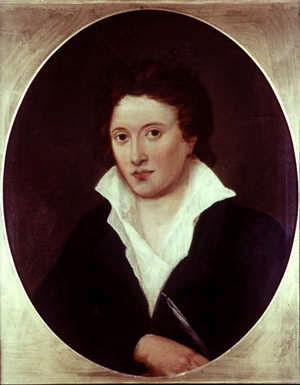
I wrote yesterday about Byron, and despite completely understanding Byron’s appeal, it is Shelley I have the crush on.
I probably first encountered Percy Bysshe Shelley’s poetry in twelfth grade. I can’t think of any reason I would have encountered him before that time. I did a group project on his poem “Ozymandias” with two classmates. We videotaped ourselves as the Shelleys and his “inspiration,” a basketball player who was past his prime and whose talent would quickly vanish, which I have to say was probably not a bad modernization of the text’s theme. Shopping in the bookstore with my parents, I found a Norton anthology of Shelley’s poetry and prose and had to have it. My dad bought it for me, and he must have been scratching his head over the purchase something fierce because what normal twelfth grader wants a Norton anthology of a British Romantic poet’s work? Even I would wonder what was up with such a kid if I met one today, but I have a sneaking suspicion I was on the extremely rare side in that particular area.
So I read some of the other poems in the Norton, and I was particularly entranced by Epipsychidion, a word Shelley made up which means “on the subject of the little soul.” This poem is about S-E-X. It is transcendent, a connection of souls. It’s written for a woman named Teresa Viviani with whom Shelley was quite enamored, but who was inaccessibly confined in a convent by her father. Just imagine! It reminds me of Romeo’s declaration that Rosaline’s decision to “remain chaste” in fact “makes huge waste.” In the poem, Shelley calls Viviani “Emilia,” the name of Hippolyta’s sister as described in The Teseida by Boccaccio. Later, Geoffrey Chaucer would rework the story in “The Knight’s Tale,” and Shakespeare and John Fletcher as Two Noble Kinsmen. Emilia, or Emily, desires to remain chaste also, but she has the misfortune to be spied by Palamone and Arcita, who fall in love with her on sight (because that’s what you do). I am much more familiar with Chaucer’s version of the story, so I’ll discuss it for a moment (still with me? bored out of your skull yet?).
In Chaucer’s story, Palamon and Arcite (same dudes, different spelling) are cousins who are like brothers. They are among the Thebans who fought against Theseus’s forces. They are captured and imprisoned in Athens, and it is from their prison window that first Palamon, then Arcite, spy Emily. They fall in love with her at first sight, but they can’t have her because they’re in prison. Eventually Arcite is released from prison, but is exiled from Athens, while Palamon remains behind bars. This scenario prompts the Knight to ask the company who has it worse: Palamon, who is imprisoned, but who can still look on Emily’s beauty from his prison window, or Arcite, who is free, but cannot see Emily. I usually ask students how they would answer the Knight’s question. How would you?
I won’t go too far into the rest of the story, but suffice it to say the men have really only fallen in love with Emily from afar. They don’t really know her, and in fact, no one really cares what she wants in all of this, which is to be a nun. Women didn’t get to choose so much in Emily’s day, however, so she eventually weds one of the cousins, and I won’t tell you which because I hope you’ll read the story. What Emily represents is the Knight’s ideal—an example of the lady on the pedestal. Of course, the Miller tells his story next, concerning men and women who are a little nearer to the earth.
At any rate, Shelley choosing that particular nickname for his beloved is fraught with all sorts of meaning. She is the unattainable Emilia, only she is imprisoned rather than her lover (presumably Shelley). Idealized, not real. Not really Teresa Viviani, but his hope for perfection. He compares his wife, Mary Shelley, to the moon—cold, chaste. Teresa is the sun (can’t help but think of Romeo and Juliet once again).
I don’t know why, but I developed a sort of crush on Shelley that has lasted since twelfth grade, over 20 years now. I don’t think Shelley was particularly nice, at least not to his wives, and I’m not sure what it is about him. He is on the page, and his opinions and beliefs shine forth in clear language, but even after all this time, I don’t feel I really know him. He is still a mystery. I am looking forward to seeing how Jude Morgan gives him flesh and life. I have no trouble imagining Byron or Keats as real people, but Shelley has remained elusive. He is, in that way, like Emilia himself. All the descriptions I’ve read of him tend toward the idealized. I hope Morgan is able to make him walk on the ground.
See Shelley’s Ghost: Reshaping the Image of a Literary Family.